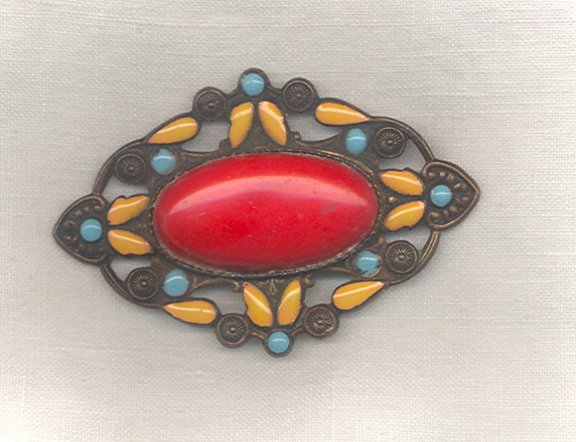The predominant jewelry style at the turn of the 20th C. is called Edwardian, after King Edward VII (1901-1910) who assumed the throne in England, after the death of his mother Queen Victoria. This style began about 1890 and extends to 1914 – the beginning of WWI. This Period is called La Belle Époque in France. It encompasses various Arts Movements, including Arts and Crafts, Art Nouveau, Les Fauves and the Wiener Werkstätte in Austria.
It was a period of both great social rigidity and great social change. Changes included the status of women, including the issue of women’s suffrage, increased economic opportunities as a result of rapid industrialization and many changes brought about by the First World War.
Jewelry fashions of the day were influenced by Princess Alexandra, (later Queen Alexandra) shown here wearing a diamond and pearl "dog collar."
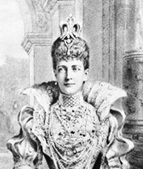
The type and style of jewelry worn is often determined by the fashions of the day. We will spend a little bit of time talking about what women were wearing in the periods we are discussing. There is an excellent Fashion Timeline on the VFG website which covers each period in far more depth - with examples of garments from 1800 – 1960’s. http://vintagefashionguild.org/fashion-timeline/
The 1890's began with a return to the heavily corseted hourglass shape of the early Victorian period. Slightly prior to the turn of the century a new type of “health” corset was invented - supposedly to give women more freedom - which forced them into an "S" curve. In the late 1890’s the silhouette slimmed and elongated. Blouses and dresses were full in front and puffed into the "pigeon breast" shape of the early 20th century that looked over the narrow waist, which sloped from back to front and was often accented with a sash or belt. Necklines were supported by very high boned collars. Pins were worn at the collar, and sash pins or fancy buckles were worn at the waist. This is the era of the Gibson Girl.
Here are some examples of Edwardian pins - both fine and costume:
This piece is fine jewelry but is a good example of the style of the Edwardian period:
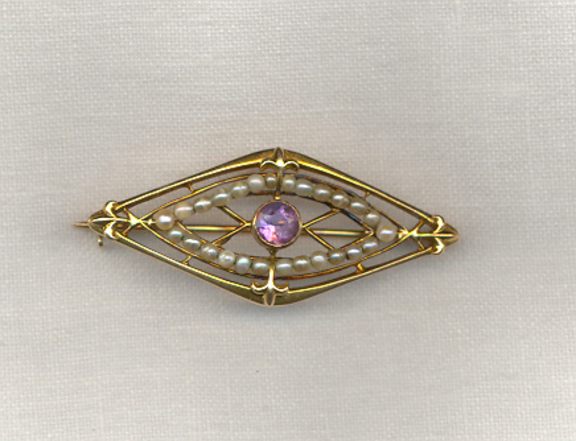
This one is costume:
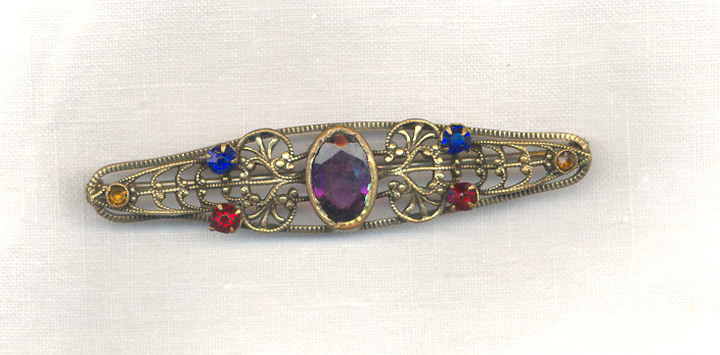
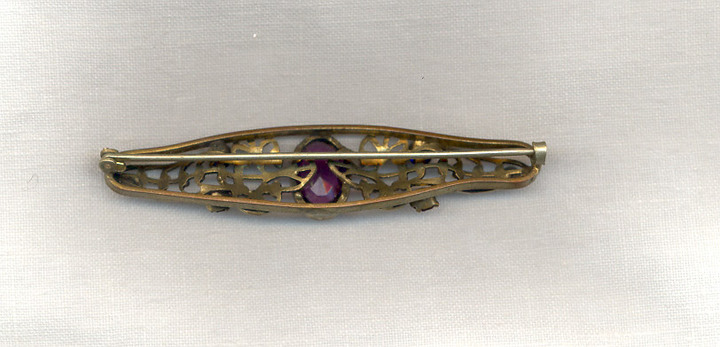
This early Cosmopolitan cover shows the Edwardian woman:
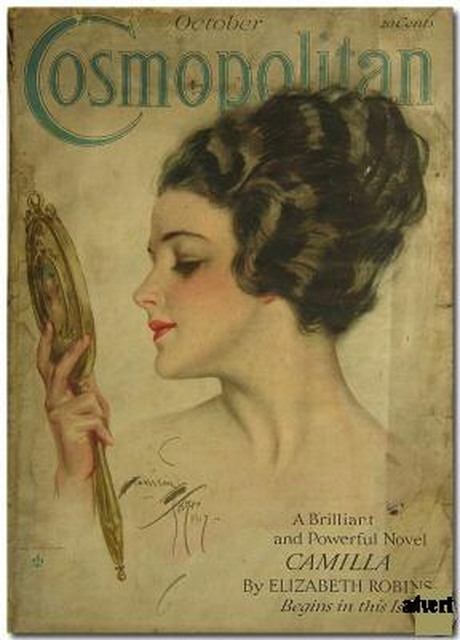
This is an early Celluloid Arts and Craft's Brooch:
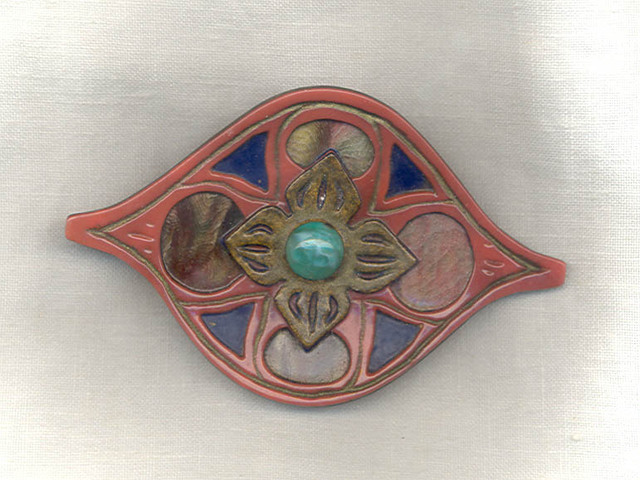
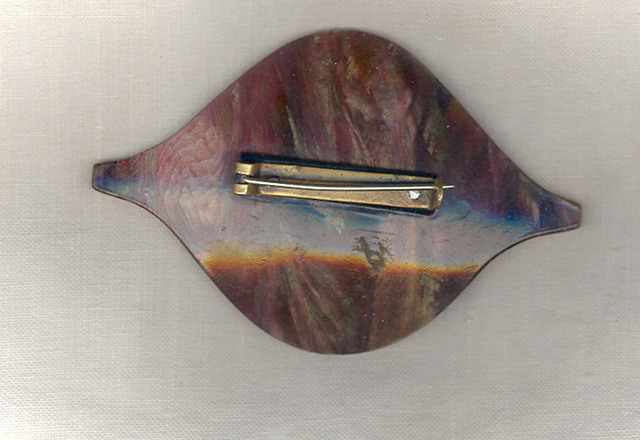
An early 20.C Belt Buckle with Art Nouveau motifs:

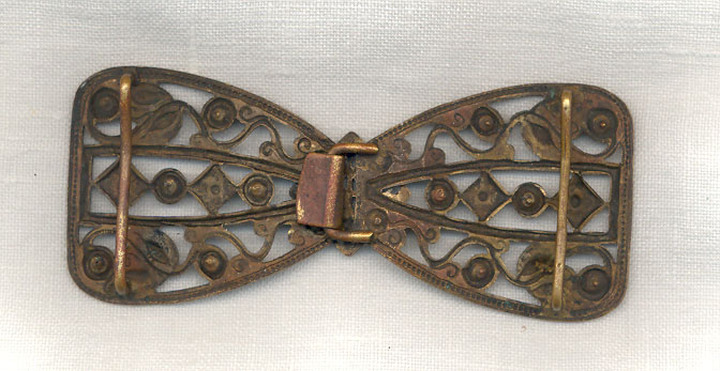
From "The Delineator" - 1901
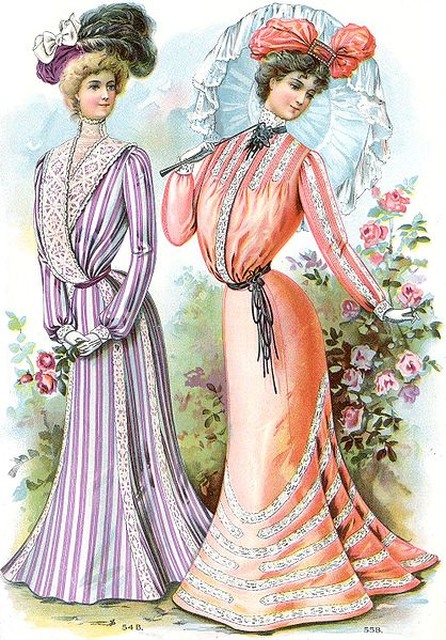
Around 1908, the Paris fashion houses began to show a new silhouette, with a thicker waist, flatter bust, and narrower hips. By the end of the decade the most fashionable skirts cleared the floor and approached the ankle. The overall silhouette narrowed and straightened, beginning a trend that would continue into the years leading up to the First World War.
During the early part of the 20C., both fine and costume jewelry was predominately small scale and "white." Pearls and diamonds were set in delicate platinum and white gold filigree. Lavaliers and delicate small gold pins worn at the collar were popular. Costume jewelry followed suit in non-precious metals and imitation gemstones. As the new century progressed jewelry was influenced not only by designers such as Poiret and Chanel but by the costumes of the Ballet Russes, "contemporary" art and design.
Fashion Designs by Paul Poiret Illustrated by Paul Iribe - 1908
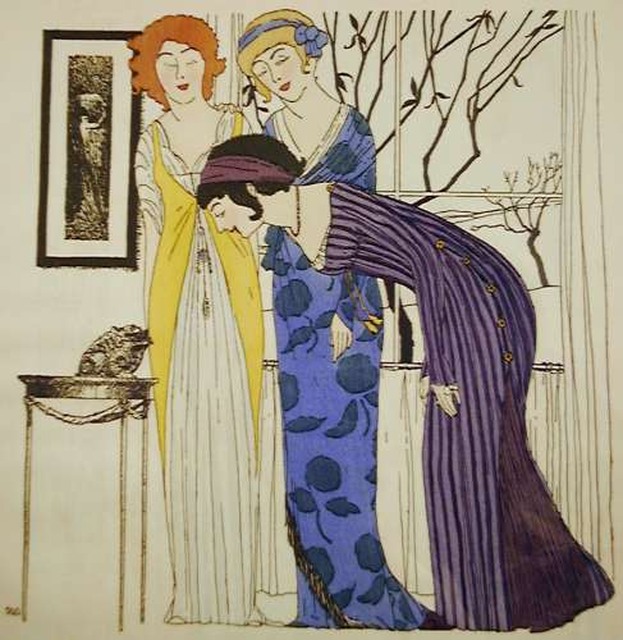
From the Jeweler's Circular - 1912
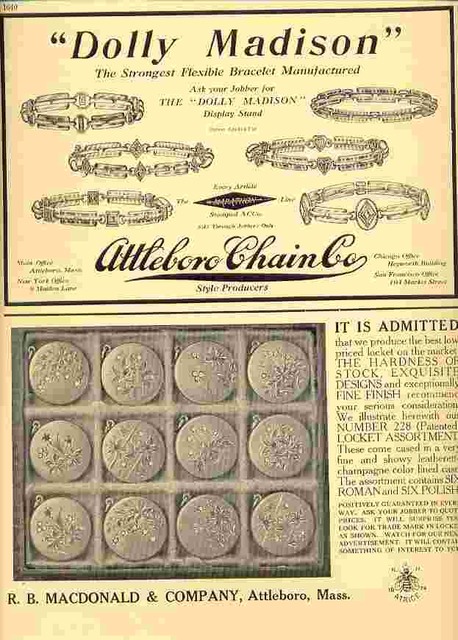
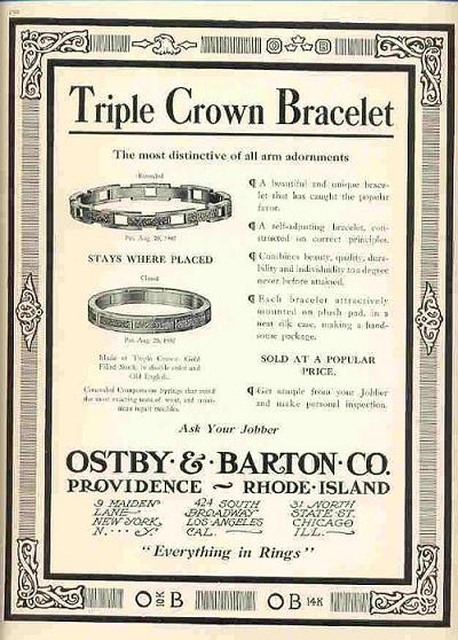
Changes in dress during World War I were dictated more by necessity than fashion. As more and more women were forced to work, they demanded clothes that were better suited to their new activities, and shirtwaists and tailored suits were worn.
We looked at this pin in Part I. It is sterling set with paste stones, C. 1915-1920.

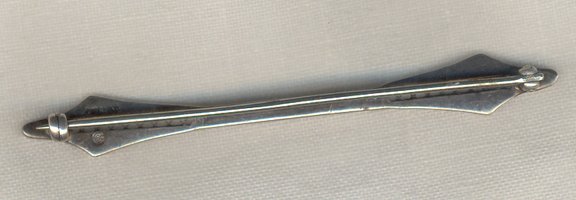
The Post WWI Woman no longer wanted to be confined and corseted. She cut her hair and wore looser, more colorful clothing which by the mid-1920's became knee length. Rather than accenting the female shape of the previous eras, the female figure became flat and boyish. The flapper was born - and this style gave rise to jewelry which showed off bobbed hair and the dropped waistline. In addition to long earrings, multiple bracelets and knee length necklaces, called sautoirs, women wore jeweled headbands or feathered aigrets and carried small beaded or jewel encrusted bags.
Early 1920's:
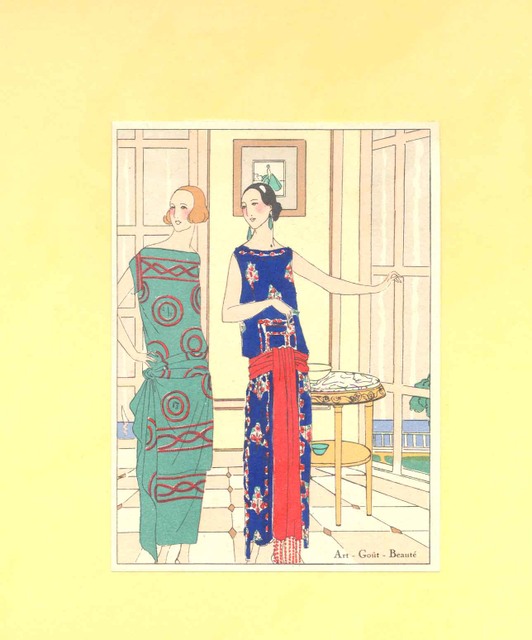
The jewelry in the early 1920's continued the pearl and diamond look of the Edwardian period but the middle part was all about color and outside influences - Egyptian, Oriental, Indian, African, etc. Art and Architecture played a large role.
The discovery of King Tut's tomb in 1923 led to a renewed interest in all things Egyptian. Here's a Cartier ad and a period costume bracelet :
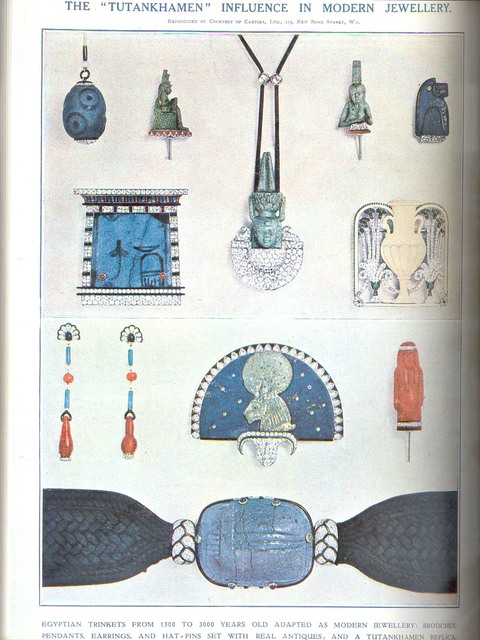

In 1925, the Paris Exposition des Arts Décoratifs et Industrielles Moderne was held. The exhibition was scheduled to be held years earlier but was postponed because of WWI. This exhibit introduced The Art Deco style (1910-1939) to the world. The term Art Deco was not coined until the very late 1960's - however the Style predominated until the start of WWII, influencing fashion, architecture, transportation – trains, planes, boats, automobiles, household appliances, furniture and jewelry!
1926:

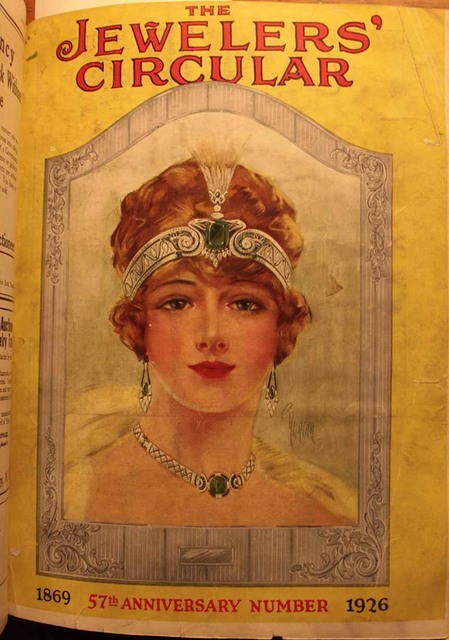
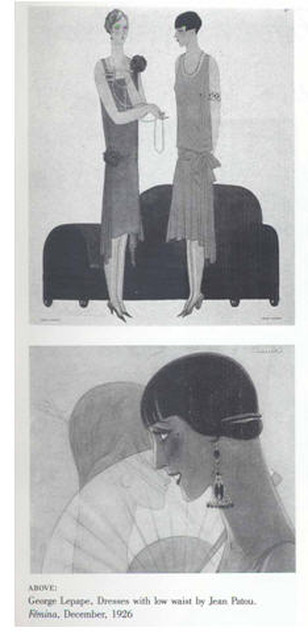
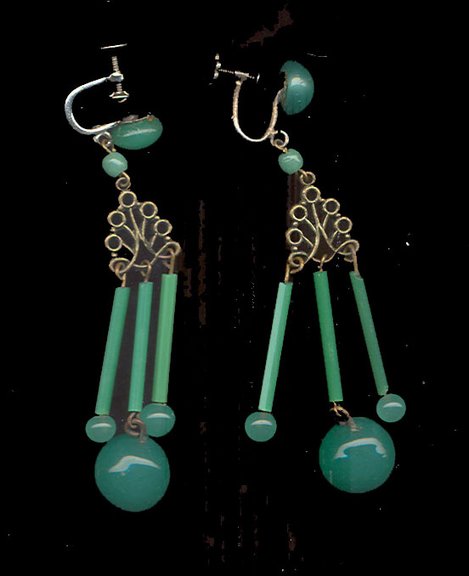
1920's costume pieces:
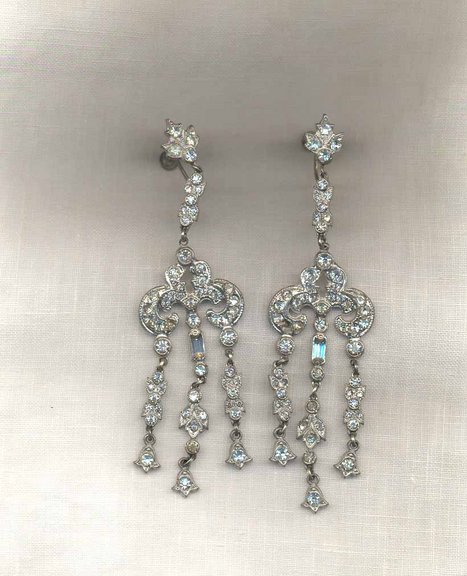
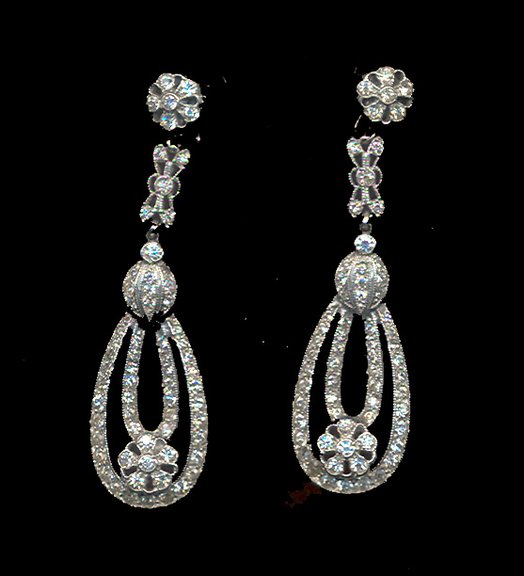
Fishel Nessler:
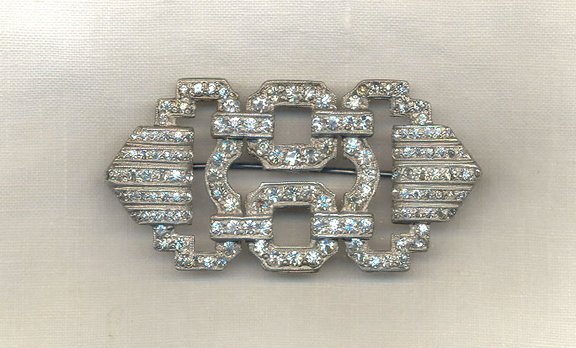

Crystal and Peking Glass beaded sautoir:
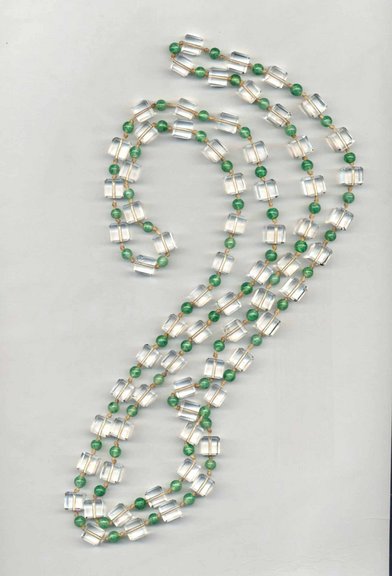
In 1926 it was "all the rage" to wear multiple bracelets:
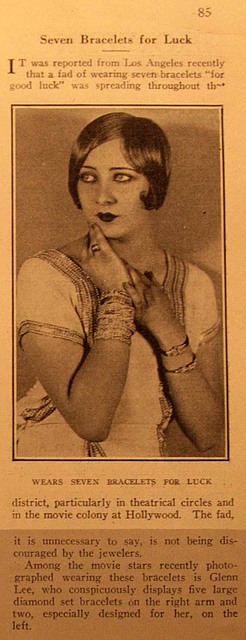
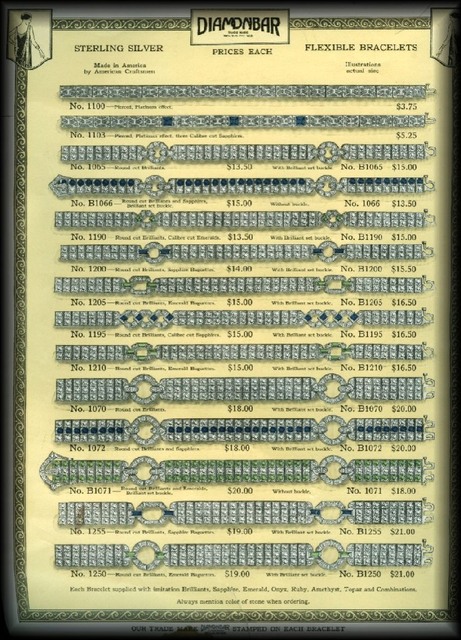
Diamonbar:

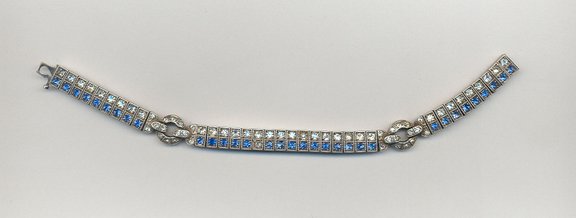
Alco:
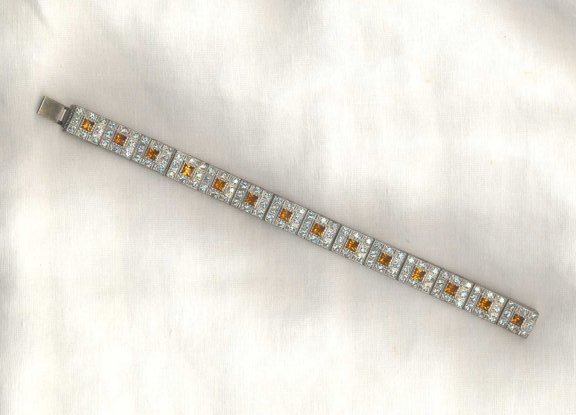
1920's Napier "Slave" bracelet:
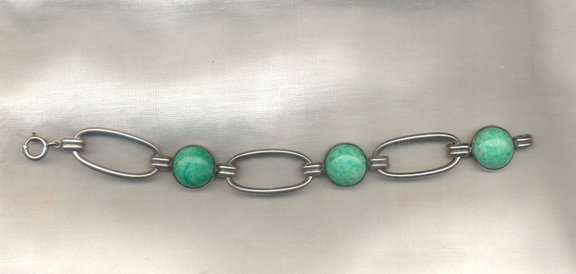
Unsigned Brass and "Faux" Lapis Slave Bracelet:

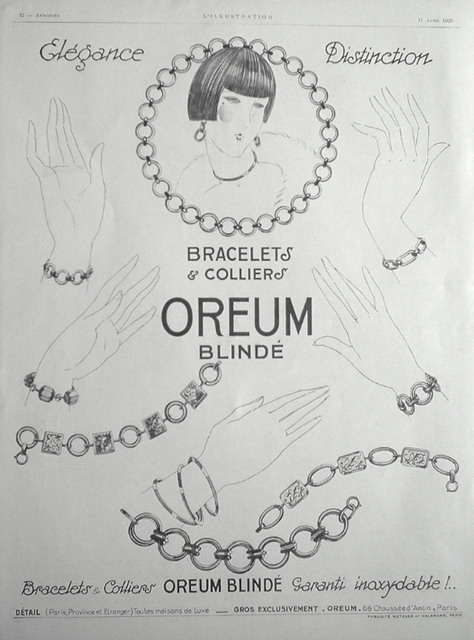
1928:
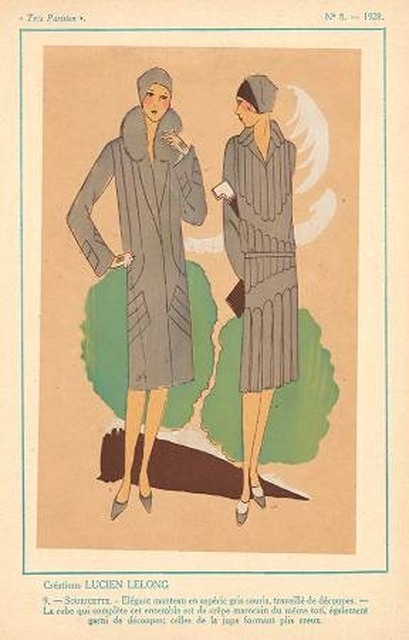
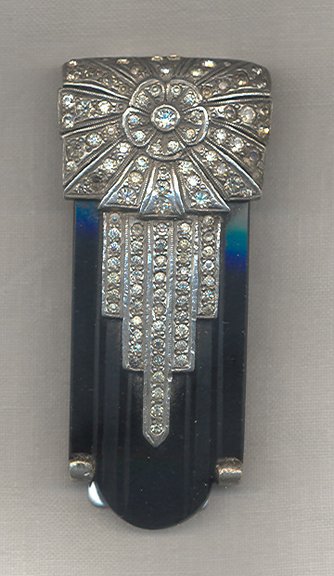
Another major influence on jewelry in the late 1920's that lasted well into the '30's and '40's was the multi-colored carved gemstones - rubies, sapphires and emeralds brought back from India by Cartier. These pieces were nicknamed “Tutti Fruitti” and later called “Fruit Salad” in costume jewelry. Trifari made many costume pieces using imitation carved glass stones in the late '30's.
Here's a 1928 piece by Cartier from the Royal Magazin website:
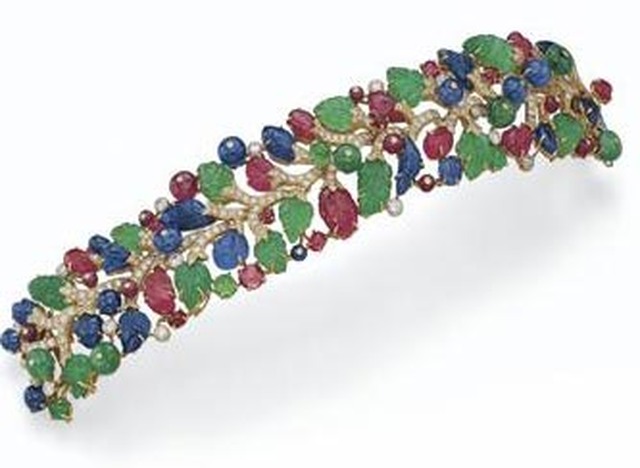
C. 1920's Costume Pieces:
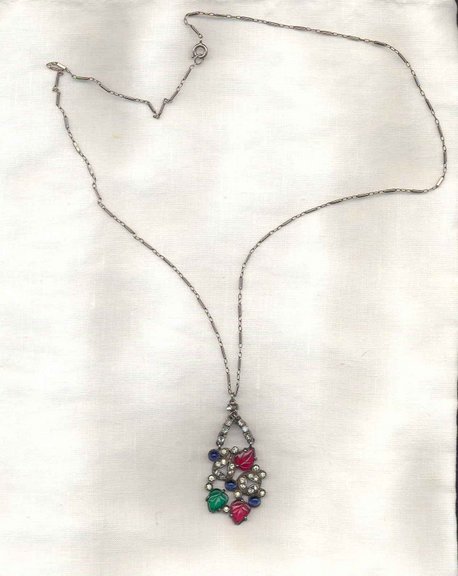
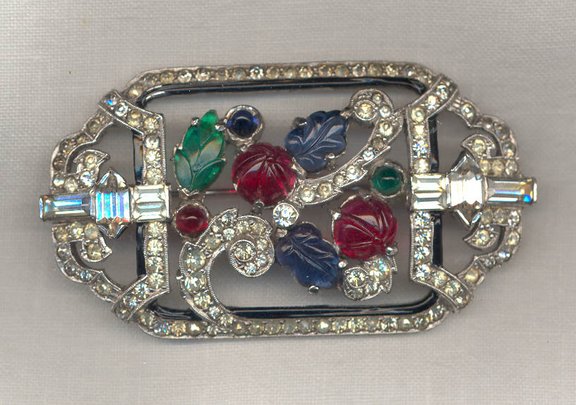

These earrings have a patent for the mechanism dated 1927. They are a great example of "stream-lined Art Deco."
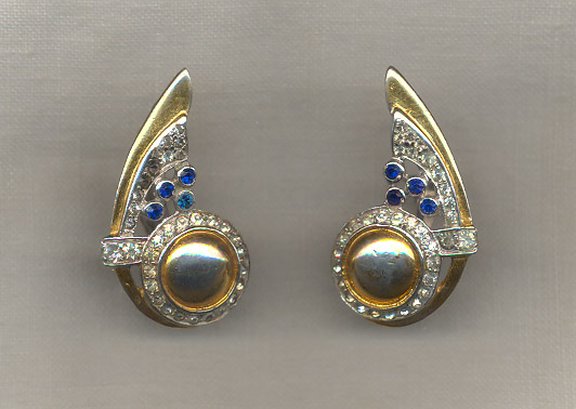
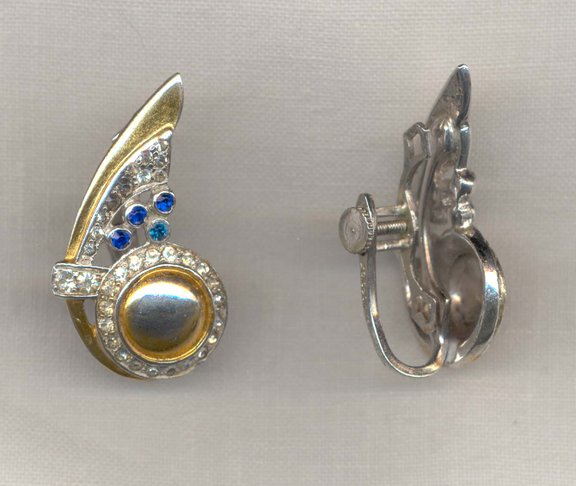
During the 1920's new materials such as Bakelite were used in costume jewelry. Bakelite jewelry was particularly popular in the '30's-'40's. Here's a sautoir made of Bakelite with rhinestone "rhondelles" and some other pieces of late 1920's costume jewelry:
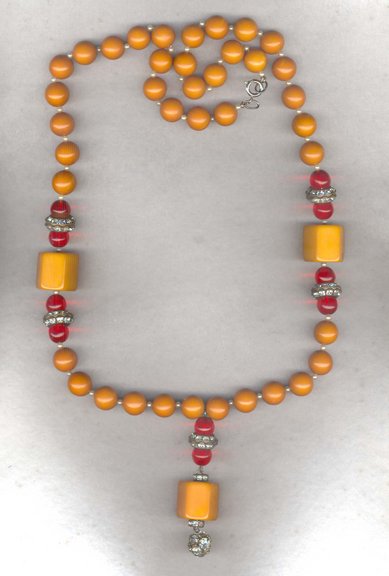
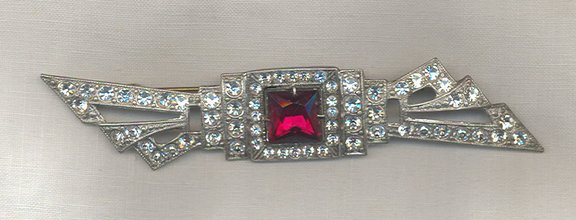
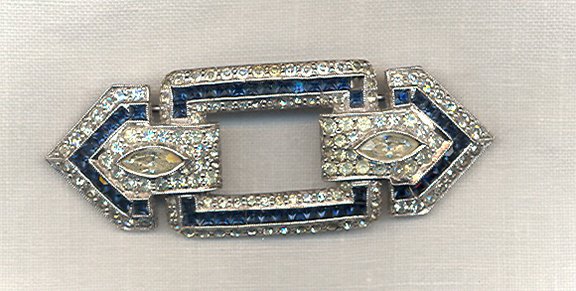
In Part III we will discuss the 1930's, streamlined Art Deco, dress clips and "convertible" dress clips.
It was a period of both great social rigidity and great social change. Changes included the status of women, including the issue of women’s suffrage, increased economic opportunities as a result of rapid industrialization and many changes brought about by the First World War.
Jewelry fashions of the day were influenced by Princess Alexandra, (later Queen Alexandra) shown here wearing a diamond and pearl "dog collar."
The type and style of jewelry worn is often determined by the fashions of the day. We will spend a little bit of time talking about what women were wearing in the periods we are discussing. There is an excellent Fashion Timeline on the VFG website which covers each period in far more depth - with examples of garments from 1800 – 1960’s. http://vintagefashionguild.org/fashion-timeline/
The 1890's began with a return to the heavily corseted hourglass shape of the early Victorian period. Slightly prior to the turn of the century a new type of “health” corset was invented - supposedly to give women more freedom - which forced them into an "S" curve. In the late 1890’s the silhouette slimmed and elongated. Blouses and dresses were full in front and puffed into the "pigeon breast" shape of the early 20th century that looked over the narrow waist, which sloped from back to front and was often accented with a sash or belt. Necklines were supported by very high boned collars. Pins were worn at the collar, and sash pins or fancy buckles were worn at the waist. This is the era of the Gibson Girl.
Here are some examples of Edwardian pins - both fine and costume:
This piece is fine jewelry but is a good example of the style of the Edwardian period:

This one is costume:


This early Cosmopolitan cover shows the Edwardian woman:

This is an early Celluloid Arts and Craft's Brooch:


An early 20.C Belt Buckle with Art Nouveau motifs:


From "The Delineator" - 1901

Around 1908, the Paris fashion houses began to show a new silhouette, with a thicker waist, flatter bust, and narrower hips. By the end of the decade the most fashionable skirts cleared the floor and approached the ankle. The overall silhouette narrowed and straightened, beginning a trend that would continue into the years leading up to the First World War.
During the early part of the 20C., both fine and costume jewelry was predominately small scale and "white." Pearls and diamonds were set in delicate platinum and white gold filigree. Lavaliers and delicate small gold pins worn at the collar were popular. Costume jewelry followed suit in non-precious metals and imitation gemstones. As the new century progressed jewelry was influenced not only by designers such as Poiret and Chanel but by the costumes of the Ballet Russes, "contemporary" art and design.
Fashion Designs by Paul Poiret Illustrated by Paul Iribe - 1908

From the Jeweler's Circular - 1912


Changes in dress during World War I were dictated more by necessity than fashion. As more and more women were forced to work, they demanded clothes that were better suited to their new activities, and shirtwaists and tailored suits were worn.
We looked at this pin in Part I. It is sterling set with paste stones, C. 1915-1920.


The Post WWI Woman no longer wanted to be confined and corseted. She cut her hair and wore looser, more colorful clothing which by the mid-1920's became knee length. Rather than accenting the female shape of the previous eras, the female figure became flat and boyish. The flapper was born - and this style gave rise to jewelry which showed off bobbed hair and the dropped waistline. In addition to long earrings, multiple bracelets and knee length necklaces, called sautoirs, women wore jeweled headbands or feathered aigrets and carried small beaded or jewel encrusted bags.
Early 1920's:

The jewelry in the early 1920's continued the pearl and diamond look of the Edwardian period but the middle part was all about color and outside influences - Egyptian, Oriental, Indian, African, etc. Art and Architecture played a large role.
The discovery of King Tut's tomb in 1923 led to a renewed interest in all things Egyptian. Here's a Cartier ad and a period costume bracelet :


In 1925, the Paris Exposition des Arts Décoratifs et Industrielles Moderne was held. The exhibition was scheduled to be held years earlier but was postponed because of WWI. This exhibit introduced The Art Deco style (1910-1939) to the world. The term Art Deco was not coined until the very late 1960's - however the Style predominated until the start of WWII, influencing fashion, architecture, transportation – trains, planes, boats, automobiles, household appliances, furniture and jewelry!
1926:




1920's costume pieces:


Fishel Nessler:


Crystal and Peking Glass beaded sautoir:

In 1926 it was "all the rage" to wear multiple bracelets:


Diamonbar:


Alco:

1920's Napier "Slave" bracelet:

Unsigned Brass and "Faux" Lapis Slave Bracelet:


1928:


Another major influence on jewelry in the late 1920's that lasted well into the '30's and '40's was the multi-colored carved gemstones - rubies, sapphires and emeralds brought back from India by Cartier. These pieces were nicknamed “Tutti Fruitti” and later called “Fruit Salad” in costume jewelry. Trifari made many costume pieces using imitation carved glass stones in the late '30's.
Here's a 1928 piece by Cartier from the Royal Magazin website:

C. 1920's Costume Pieces:



These earrings have a patent for the mechanism dated 1927. They are a great example of "stream-lined Art Deco."


During the 1920's new materials such as Bakelite were used in costume jewelry. Bakelite jewelry was particularly popular in the '30's-'40's. Here's a sautoir made of Bakelite with rhinestone "rhondelles" and some other pieces of late 1920's costume jewelry:



In Part III we will discuss the 1930's, streamlined Art Deco, dress clips and "convertible" dress clips.


